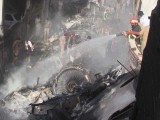
Here is what is etched in my memory in the aftermath of the crash: A grieving father being pushed for comment on television. As if the unfathomable loss alone was not enough, victim’s families at the behest of reporters who are badgering them for an ‘interview’. The mourners, who can barely contain themselves, struggle to utter a few words before they break into a disarray of emotions. Their eyelashes are drenched and a heartfelt score is playing in the background. On May 22, a PIA jetliner with 99 passengers aboard crashed in a populated neighbourhood in Karachi. The locality, only few miles away from the runway, sent residents into arrest. A thick cloud of smoke billowed from the area as the aircraft caught fire. Video clips quickly started making rounds on social media and traditional Pakistani media was overwhelmed with breaking news updates spiking traffic on news channels and websites nationwide. But there was one thing that remained largely unaccounted for, the casualties in the crash and the fact that there were survivors. However, it was too late. By this time, news outlets had embarked on a vicious rat race, trading information in exchange for eyeballs. Most of them had released the flight manifest – an otherwise confidential document – thereby giving an impression that all passengers aboard had been presumed dead. The media had turned into what can be described as a bazaar; milking ratings and overlooking in the process that this disaster left many homes in shambles and many families without factual information about their loved ones. As a journalist, impatient for information, and a Karachiite sitting miles from home, I rummaged through the live feeds of most news outlets. I saw newscasters assuming all on board to have been dead, a full passenger list, photos of the ‘presumably’ deceased and an enthusiastic undertone in the delivery of the news, all of which lacked sensitivity at best. The media melodrama overshadowed a tragedy yet again. At this point, the local media had turned into a monster with very little regard for what would ensue when families of the victims would see photos of their loved ones’ flash across screens. And as a result, loss of credibility for the media when some of those declared deceased have returned as though resurrected from the dead. Add to the plethora of existing news channels, the emergence of social media, which was even more brutal. Renowned senior journalists and critics, some of whom I look up to, took a jibe at the airline and questioned the pilot’s technical skills without conclusive evidence. Another clip to go viral was one which was presented as footage from the plane in the last few seconds before the crash. No authenticity of this clip was by far established. More disinformation circulated when leading news channels used a picture of a PIA airliner which turned out to be bogus as it was reportedly a screengrab from a video that surfaced last year. On open source information, such as an audio file comprising a conversation between the pilot and the control tower, could probably be held off for publishing until later. What further appeared as blatant disregard was a reporter proudly stating that he was reporting from a live scene of carnage or at one point from an airhostess’s home where he pressed the family for comment. By this time, social media was replete with speculations on who could possibly be survivors. The flight manifests had been taken off air as hospital authorities confirmed that they were still identifying bodies. But it was too late to make amends. The coverage had reached the ins and outs of the internet, vehemently coming off as an industry where workers had little training to tackle disaster situations. In response to the media frenzy, journalists across social media platforms mobilised resistance, calling out news agencies over their irresponsible coverage of the incident. During the course of my rather brief journalistic career, I can recall several instances where the media treated a tragedy as an opportunity for gains. But the question is, how long before we collectively realise that garnering attention by shoddy means isn’t just fleeting but also disreputable?